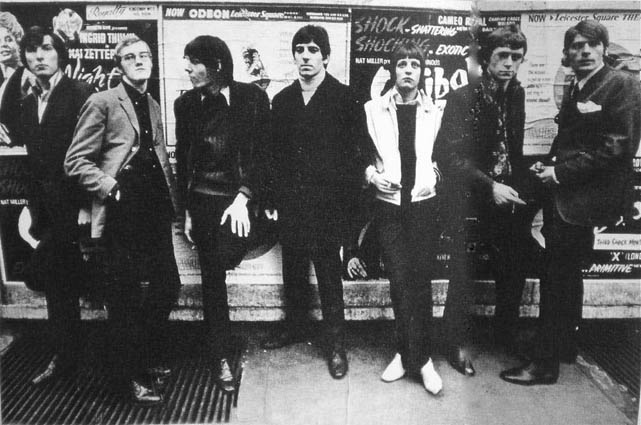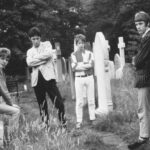
The Alan Bown Set – a musically daring mix of horns and rock – was conceived in the Summer of 1965 by four former John Barry Seven members: Alan Bown (trumpet); Dave Green (saxophone / flute); Jeff Bannister (organ / vocals); Stan Haldane (bass) together with Vic Sweeney (drums) and Pete Burgess (guitar).
Bown’s musical career began after his stint in National Service during which he served with the Royal Air Force.
He formed his first group in the early ‘60’s and performed as far afield as the Star Club in Hamburg, crossing paths with The Beatles and others who were treading the same, burgeoning, musical path.
Jess remembers…
“The ‘Shakes’ were on the verge of splitting up when, on a Friday night, sometime in February, we played a gig at Digbeth Civic Hall in Birmingham supporting a band from London called the Alan Bown Set.
‘I thought that the AB boys were good.
‘What we were doing in The Shakedown Sound was… We started out as a kind of straight ahead blues band, but then morphed into a mod-Blues band where you started to do some Otis Redding bits ‘n pieces in the set as opposed to all the Screamin’ Jay Hawkins and T-Bone Walker kinda things.
‘But… there wasn’t any real prospect in The Shakes of making a real record or anything like that. So… it was really a logical choice to make… and, pretty much from the word go, it was full-on.”
The first single Jess recorded with The Alan Bown Set was ‘Everything’s Gonna Be Alright’ c/w ‘Baby Don’t Push Me.’ … which was fairly quickly followed by their take on the Edwin Starr original of ‘Headline News’ c/w ‘Mister Pleasure.’
‘I could have only been doing three or four songs with them at that time and Jeff would have still been doing ‘I’m The One Who Loves You’, y’know all The Impressions stuff that they also did.
‘Tony Reeves who ended up being the bass player in Colosseum and worked with John Mayall and other people. He was one of the house producers for Pye working under Tony Hatch. And, that was my first time in a proper studio and working with a proper producer
‘So, we did those – they were just three hour sessions. And then, of course, we set in to the gigging scenario
The band were also becoming television veterans having appeared on Alan Freeman’s show – All Systems Freeman; the Simon Dee Show and Eamonn Andrew’s “Today”. They also played London’s Royal Albert Hall – a show which included both Joe Cocker as well as the Bonzo Dog Doo-Dah Band.
The former coming off the back of his Woodstock appearance and With A Little Help From My Friends, the latter having hit the high spots with The Doughnut In Granny’s Greenhouse, an album peppered with such luxurious track-titles as My Pink Half Of The Drainpipe, I’m The Urban Spaceman and Trouser Press.
However, it was in August that the cruelest of luck beset The Alan Bown following an appearance on the BBC’s flagship music programme, Top Of The Pops. With their single, We Can Help You – a cover of the Patrick Campbell-Lyons and Alex Spyropoulos of Nirvana original that appeared on that group’s Story Of Simon Simopath debut LP for Island Records – riding high at #26, the TOTP airing on August 8th virtually guaranteed a top ten placing for the single when the following week’s British charts were published.
However, the record company’s pressing plant went on strike and production halted.
The band’s manager took out a court injunction but, by the time the dispute had been resolved, We Can Help You had lost all sales momentum and disappeared off the face of the charts.
Emergency 999
<iframe width=”560″ height=”315″ src=”https://www.youtube.com/embed/U8IUcKRWp6E” title=”YouTube video player” frameborder=”0″ allow=”accelerometer; autoplay; clipboard-write; encrypted-media; gyroscope; picture-in-picture” allowfullscreen></iframe>
Emergency 999 – a song that garnered a lot of momentum on the Northern Soul scene – followed suit as did a gigging schedule up and down the length and breadth of Britain.
For every major venue the group played there were sometimes seen in the most unlikely of places – such as a village hall in New Erswhick just outside York, the venue for that particular night being named The Tinned Chicken.
‘We rehearsed quite a bit. We used to rehearse at a place in Hanwell.
‘When we were doing new tunes, we would go there perhaps twice a month. We were just getting busier and busier – the whole live thing was growing and growing and growing.
‘We were working right across the country – in the North like at the Mojo, we were there every month and a half or so; Redcar at the Coatham Bowl up there, the Country Club that was owned by John McCoy and his brothers in Middlesborough; Newcastle too.
‘The smaller clubs were sort of stop-off places to the likes of the Coatham Bowl which was a big ballroom in a hotel that probably held about eight hundred people…
‘And, this was the circuit that everyone was on… well, anyone who was anyone at the time… The Who, Small Faces, everyone you can think of… all playing the same venues.
‘I don’t really remember days off as such, we were constantly working.
‘Financially, it was better than the Shakedown Sound because we didn’t hardly earn anything then but, it still wasn’t a great deal, though it was alright – I bought my first car off my sister and stuff like that which I couldn’t have afforded to do prior to then.”
In July and with their stock rising, the group appeared on the seminal TV show, Ready Steady Go. Later the same month, they played the inaugural Windsor Jazz & Blues Festival and, in September one of their electrifying live shows at London’s Marquee Club was caught on tape and released as one half of a live album – the other side being devoted to another club-land legend in the making, Jimmy James and The Vagabonds.
Before the year was out, however, yet another personnel change occurred as Tony Catchpole replaced Pete Burgess on guitar.


